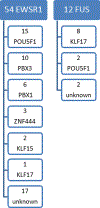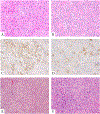A morphologic and molecular reappraisal of myoepithelial tumors of soft tissue, bone, and viscera with EWSR1 and FUS gene rearrangements
- PMID: 31994243
- PMCID: PMC7170037
- DOI: 10.1002/gcc.22835
A morphologic and molecular reappraisal of myoepithelial tumors of soft tissue, bone, and viscera with EWSR1 and FUS gene rearrangements
Abstract
Myoepithelial tumors (MET) represent a clinicopathologically heterogeneous group of tumors, ranging from benign to highly aggressive lesions. Although MET arising in soft tissue, bone, or viscera share morphologic and immunophenotypic overlap with their salivary gland and cutaneous counterparts, there is still controversy regarding their genetic relationship. Half of MET of soft tissue and bone harbor EWSR1 or FUS related fusions, while MET arising in the salivary gland and skin often show PLAG1 and HMGA2 gene rearrangements. Regardless of the site of origin, the gold standard in diagnosing a MET relies on demonstrating its "myoepithelial immunophenotype" of positivity for EMA/CK and S100 protein or GFAP. However, the morphologic spectrum of MET in soft tissue and bone is quite broad and the above immunoprofile is nonspecific, being shared by other pathogenetically unrelated neoplasms. Moreover, rare MET lack a diagnostic immunoprofile but shows instead the characteristic gene fusions. In this study, we analyzed a large cohort of 66 MET with EWSR1 and FUS gene rearrangements spanning various clinical presentations, to better define their morphologic spectrum and establish relevant pathologic-molecular correlations. Genetic analysis was carried out by FISH for EWSR1/FUS rearrangements and potential partners, and/or by targeted RNA sequencing. Then, 82% showed EWSR1 rearrangement, while 18% had FUS abnormalities. EWSR1-POU5F1 occurred with predilection in malignant MET in children and young adults and these tumors had nested epithelioid morphology and clear cytoplasm. In contrast, EWSR1/FUS-PBX1/3 fusions were associated with benign and sclerotic spindle cell morphology. Tumors with EWSR1-KLF17 showed chordoma-like morphology. Our results demonstrate striking morphologic-molecular correlations in MET of bone, soft tissue and viscera, which might have implications in their clinical behavior.
Keywords: EWSR1; FUS; PBX1; PBX3; POU5F1; myoepithelial tumors.
© 2020 Wiley Periodicals, Inc.
Conflict of interest statement
Figures




Similar articles
-
EWSR1-POU5F1 fusion in soft tissue myoepithelial tumors. A molecular analysis of sixty-six cases, including soft tissue, bone, and visceral lesions, showing common involvement of the EWSR1 gene.Genes Chromosomes Cancer. 2010 Dec;49(12):1114-24. doi: 10.1002/gcc.20819. Genes Chromosomes Cancer. 2010. PMID: 20815032 Free PMC article.
-
Pigmented (melanotic) myoepithelial tumor of soft tissue with EWSR1-KLF17 fusion.Cancer Genet. 2020 Aug;246-247:48-52. doi: 10.1016/j.cancergen.2020.08.001. Epub 2020 Aug 12. Cancer Genet. 2020. PMID: 32829130
-
Novel FUS-KLF17 and EWSR1-KLF17 fusions in myoepithelial tumors.Genes Chromosomes Cancer. 2015 May;54(5):267-75. doi: 10.1002/gcc.22240. Epub 2015 Feb 23. Genes Chromosomes Cancer. 2015. PMID: 25706482 Free PMC article.
-
Myoepithelial Tumors of Bone.Surg Pathol Clin. 2017 Sep;10(3):657-674. doi: 10.1016/j.path.2017.04.010. Epub 2017 Jun 29. Surg Pathol Clin. 2017. PMID: 28797507 Review.
-
Myoepithelial neoplasms of soft tissue: an updated review of the clinicopathologic, immunophenotypic, and genetic features.Head Neck Pathol. 2015 Mar;9(1):32-8. doi: 10.1007/s12105-015-0618-0. Epub 2015 Mar 25. Head Neck Pathol. 2015. PMID: 25804378 Free PMC article. Review.
Cited by
-
Non-cutaneous syncytial myoepitheliomas are identical to cutaneous counterparts: a clinicopathologic study of 24 tumors occurring at diverse locations.Virchows Arch. 2023 Nov;483(5):665-675. doi: 10.1007/s00428-023-03609-3. Epub 2023 Aug 7. Virchows Arch. 2023. PMID: 37548750
-
Reappraisal of soft tissue myoepithelial tumors by DNA methylation profiling reveals an epigenetically distinct group of mostly fusion-driven neoplasms.Virchows Arch. 2025 Mar;486(3):573-584. doi: 10.1007/s00428-024-03977-4. Epub 2024 Dec 5. Virchows Arch. 2025. PMID: 39636306 Free PMC article.
-
Undifferentiated round cell sarcomas with novel SS18-POU5F1 fusions.Genes Chromosomes Cancer. 2020 Nov;59(11):620-626. doi: 10.1002/gcc.22879. Epub 2020 Jul 6. Genes Chromosomes Cancer. 2020. PMID: 32557980 Free PMC article.
-
Histological and imaging features of myoepithelial carcinoma of the bone and soft tissue.Skeletal Radiol. 2024 Dec;53(12):2617-2625. doi: 10.1007/s00256-024-04693-5. Epub 2024 Apr 29. Skeletal Radiol. 2024. PMID: 38679636
-
Long-term follow-up of metastatic renal myoepithelial carcinoma: case report and literature review.Can J Urol. 2025 Jun 27;32(3):167-172. doi: 10.32604/cju.2025.063279. Can J Urol. 2025. PMID: 40567083 Review.
References
-
- Hornick JL, Fletcher CD. Myoepithelial tumors of soft tissue: a clinicopathologic and immunohistochemical study of 101 cases with evaluation of prognostic parameters. Am J Surg Pathol. 2003;27:1183–1196. - PubMed
-
- Song W, Flucke U, Suurmeijer AJH. Myoepithelial Tumors of Bone. Surg Pathol Clin. 2017;10:657–674. - PubMed
-
- Katabi N, Gomez D, Klimstra DS, et al. Prognostic factors of recurrence in salivary carcinoma ex pleomorphic adenoma, with emphasis on the carcinoma histologic subtype: a clinicopathologic study of 43 cases. Hum Pathol. 2010;41:927–934. - PubMed
Publication types
MeSH terms
Substances
Grants and funding
LinkOut - more resources
Full Text Sources
Medical
Research Materials
Miscellaneous

